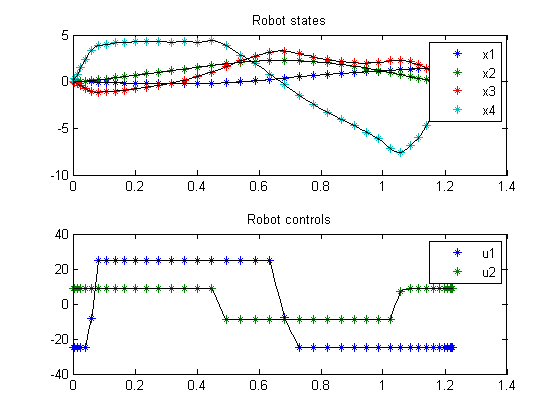Two-Link Robot
Contents
Problem description
Singular time-optimal 2 Link robot control
From the paper: L.G. Van Willigenburg, 1991, Computation of time-optimal controls applied to rigid manipulators with friction, Int. J. Contr., Vol. 54, no 5, pp. 1097-1117
Programmers: Gerard Van Willigenburg (Wageningen University) Willem De Koning (retired from Delft University of Technology)
% Copyright (c) 2009-2009 by Tomlab Optimization Inc.
Problem setup
% Array with consecutive number of collocation points narr = [20 40]; toms t tf % Free final time for n=narr
p = tomPhase('p', t, 0, tf, n); setPhase(p) tomStates x1 x2 x3 x4 tomControls u1 u2 % Initial & terminal states xi = [0; 0; 0; 0]; xf = [1.5; 0; 0; 0]; % Initial guess if n==narr(1) x0 = {tf==1; icollocate({x1 == xi(1); x2 == xi(2) x3 == xi(3); x4 == xi(4)}) collocate({u1 == 0; u2 == 0})}; else x0 = {tf==tfopt; icollocate({x1 == xopt1; x2 == xopt2 x3 == xopt3; x4 == xopt4}) collocate({u1 == uopt1; u2 == uopt2})}; end % Box constraints cbox = {0.75 <= tf <= 1.5; -25 <= collocate(u1) <= 25 -9 <= collocate(u2) <= 9}; % Boundary constraints cbnd = {initial({x1 == xi(1); x2 == xi(2) x3 == xi(3); x4 == xi(4)}) final({x1 == xf(1); x2 == xf(2) x3 == xf(3); x4 == xf(4)})}; % ODEs and path constraints % Robot parameters mm11 = 5.775; mm12 = 0.815; mm22 = 0.815; hm11 = 1.35; m1 = 30.0; m2 = 15; % Variables for dynamics c1 = cos(x1); c2 = cos(x2); s2 = sin(x2); c12 = cos(x1+x2); ms1 = mm11+2*hm11*c2; ms2 = mm12+hm11*c2; det = ms1.*mm22-ms2.*ms2; ms11 = mm22./det; ms12=-ms2./det; ms22=ms1./det; qg1 = -hm11*s2.*(x4.*x4+2*x3.*x4); qg2 = hm11*s2.*x3.*x3; dx1 = x3; dx2=x4; dx3 = ms11.*(u1-qg1)+ms12.*(u2-qg2); dx4 = ms12.*(u1-qg1)+ms22.*(u2-qg2); ceq = collocate({ dot(x1) == dx1 dot(x2) == dx2 dot(x3) == dx3 dot(x4) == dx4}); % Objective objective = tf;
Solve the problem
options = struct;
options.name = '2-Link-Robot';
solution = ezsolve(objective, {cbox, cbnd, ceq}, x0, options);
tfopt = subs(tf,solution);
xopt1 = subs(x1,solution);
xopt2 = subs(x2,solution);
xopt3 = subs(x3,solution);
xopt4 = subs(x4,solution);
uopt1 = subs(u1,solution);
uopt2 = subs(u2,solution);
Problem type appears to be: lpcon
===== * * * =================================================================== * * *
TOMLAB - Tomlab Optimization Inc. Development license 999001. Valid to 2010-02-05
=====================================================================================
Problem: --- 1: 2-Link-Robot f_k 1.225664454423204000
sum(|constr|) 0.000001093433115014
f(x_k) + sum(|constr|) 1.225665547856319000
f(x_0) 1.000000000000000000
Solver: snopt. EXIT=0. INFORM=1.
SNOPT 7.2-5 NLP code
Optimality conditions satisfied
FuncEv 1 ConstrEv 2685 ConJacEv 2685 Iter 599 MinorIter 5285
CPU time: 6.593750 sec. Elapsed time: 6.625000 sec.
Problem type appears to be: lpcon
===== * * * =================================================================== * * *
TOMLAB - Tomlab Optimization Inc. Development license 999001. Valid to 2010-02-05
=====================================================================================
Problem: --- 1: 2-Link-Robot f_k 1.223303492296659200
sum(|constr|) 0.000000649417532893
f(x_k) + sum(|constr|) 1.223304141714192100
f(x_0) 1.225664454423204000
Solver: snopt. EXIT=0. INFORM=1.
SNOPT 7.2-5 NLP code
Optimality conditions satisfied
FuncEv 1 ConstrEv 37 ConJacEv 37 Iter 13 MinorIter 321
CPU time: 0.296875 sec. Elapsed time: 0.297000 sec.
end figure(1) subplot(2,1,1); ezplot([x1; x2; x3; x4]); legend('x1','x2','x3','x4'); title('Robot states'); subplot(2,1,2); ezplot([u1; u2]); legend('u1','u2'); title('Robot controls');
